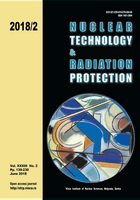
A MATHEMATICAL MODEL OF SEMICONDUCTOR DETECTOR GAMMA-EFFICIENCY CALIBRATION FOR RECTANGULAR CUBOID (BRICK-SHAPE) SOURCES

Vol.
XXXIII, No. 2, Pp. 139-230
June 2018
UDC 621.039+614.876:504.06
ISSN 1451-3994
Pages: 139-149
Authors: Nikola N. Mihaljevic, Slobodan I. Jovanovic, Aleksandar D. Dlabac,
and Mohamed S. BadawiAbstract
Rectangular cuboid (rectangular parallelepiped), i. e., brick-shape sources are not really common in general gamma-spectrometry practice with semiconductor detectors, where axially symmetrical sources prevail. However, in some particular applications, like radioactivity control of food or construction materials (for monitoring and regulatory purposes, radiological emergency preparedness, or in the aftermath of nuclear accidents), brick shapes may come to significance. In order to simplify routine/repetitive low activity measurements, it is easier and more practical to measure the radioactivity of these sources as such, i. e., without transforming them into “regular” (cylindrical or Marinelli) shapes. This saves considerably on laboratory time, workforce and consumables – thus eventually cutting the cost of analysis and improving laboratory performance. In addition, the accuracy of the analytical results is enhanced, as the possibilities for systematic errors are reduced. To that aim, in the present work a mathematical model for brick-source efficiency calibration is developed. The well known, accurate and widely used efficiency transfer principle is applied, together with detector efficiency calculations based on the effective solid angle ? concept. For testing purposes, comparisons are made with previously developed and well established mathematical models for detector calibration involving axially symmetrical sources (point, disc, and cylinder). Namely, brick sources were regarded as a sort of interpolation between the outer and inner cylinder of the same height, for which efficiencies could be accurately determined by numerical calculations (software ANGLE). For the sake of completeness, the equivoluminous cylinders were taken into account as well. Brick shape sources of various sizes and proportions were examined; when approaching zero dimensions, results were obtained for point and disc sources. All calculations were performed in gamma energy range 50-3000 keV. The results are consistent and logical, with no discrepancies indicating bugs or systematic errors – thus convincingly confirming the fundamentality and reliability of the model. The model is about to be incorporated into ANGLE software as a new functionality, so as to make it available to gamma spectrometry community.
Key words: gamma spectrometry, detection efficiency, detector calibration, rectangular cuboid source, mathematical model, numerical testing, applicability
FULL PAPER IN PDF FORMAT (1,78 MB)